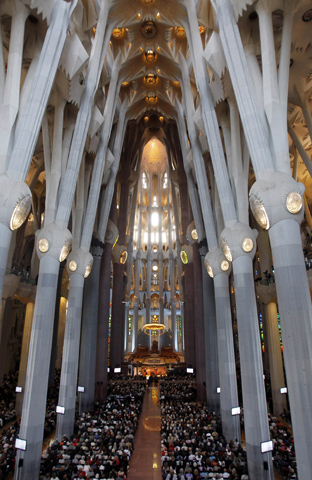
People attend a "Courtyard of the Gentiles" dialogue in May 2012 inside the Basilica of the Sagrada Familia in Barcelona, Spain. (CNS/Reuters/Albert Gea)
A few weeks ago, in response to an article at RealClearReligion bemoaning ugly churches, I invited readers to submit the names of churches they thought were beautiful. I wish to thank all the commenters who sent in their selections. Indeed, I was especially grateful to those who called attention to churches I had never seen before but that certainly matched anyone's criterion of beauty; for example, the St. Francis de Sales Cathedral in Baker, Ore., and St. James Church and St. Ann Church, both in Ohio, which are very beautiful parish churches.
I have compiled my own list and decided to exclude any churches nominated by commenters, not because mine are better but on the theory "the more the merrier." I further decided to break down the categories between cathedrals and churches and to create one category for Europe and one for the U.S. I am not familiar enough with the churches of Latin America, Africa or Asia to really appraise them.
The church of St. Cyriakus in Gernrode, Germany, is one of the finest extant examples of Ottonian architecture in the world. Ottonian architecture is earlier than the great Romanesque cathedrals of Speyer and Worms, and it is closer in style as well as time to the Roman basilicas such as Sant' Apollinare in Ravenna or Santa Maria Maggiore in Rome. St. Cyriakus is massive and heavy in construction, and the church lacks the external light we associate with later Gothic cathedrals, but the tall white-washed walls largely offset any sense of darkness and the series of steps leading to the altar introduce plenty of movement into the design. The introduction of an arcade breaks up the large walls and introduces a sense of rhythm to the whole. The outside is also massive, and the heaviness here is offset by the towers at the west end and the smaller tower at the crossing, as well as the blind arcades that line the exterior of the nave.
Runners-up in this category (again restricting myself to churches not nominated by others): Sainte-Foy in Conques, France, one of the earliest pilgrimage churches along the route to Santiago de Compostela; Abbaye Notre Dame, Morienval, France; Saint Etienne du Mont in Paris; San Clemente and Ss. Nereo e Achilleo in Rome; Santa Maria Gloriosa dei Frari, Venice; St. Mary's in Krakow; King's College Chapel (Anglican) in Cambridge.
The Mission of San Carlo Borromeo in Carmel, Calif., enjoys not only an exquisite location but a beautifully preserved interior dripping equally in beauty and history. Its reredos is less sumptuous than those found at San Xavier del Bac, to be sure, and the exterior of the mission in Santa Barbara is more elaborate. But the rusticness of the artwork one encounters at Carmel is part of its beauty, and the gardens outside make this one of the most tranquil places on earth. The church also contains an exquisitely fun memory. In my younger days, I was a serious, not to say accomplished, organist, and when I was visiting a church, I would call ahead to see if it was possible to play the organ there. The organist at the Carmel mission was delighted, so I brought some music. The instrument is a Casavant, but modeled after a Spanish colonial organ in tone and stoplist, quite different from the Casavants I knew from New England, which were all tributes to the French Romantic tradition. The day I was there, a large number of tourists had gotten off their bus. I could tell they were not Catholics -- no one blessed themselves with holy water or genuflected. And so, rather than starting out slowly with something quiet, amidst the quiet of the church I launched into a full-organ, complete with trumpets, rendition of a piece of loud Spanish music. The people almost leapt out of their skins.
Runners-up for most beautiful church in U.S.: Old Ship Church, Hingham, Mass.; King's Chapel, (originally Anglican, now Unitarian) Boston; Trinity Episcopal Church, Boston; St. Mary, Star of the Sea, New London, Conn.; Duke University Chapel; St. Michael's Episcopal Church, Charleston, S.C.; Immaculate Conception Church, Natchitoches, La.; Sacred Heart Catholic Church, Galveston, Texas.
The Kremlin's Cathedral of the Dormition, or the Assumption as we call it in the West, is one of the most ethereal places on earth. It is interesting to me that the Soviets did not tear it down: How does one turn a work of such unearthly beauty into a mere cultural or historical artifact? The iconostasis is covered in exquisite icons, the walls and even the columns that support the roof are covered in beautiful Byzantine paintings. Light dances around the space. Indeed, the beauty of the individual parts leads one to almost neglect the fact that the church is designed with a harmonious sense of proportion, such as the slender arches that crown the façade. When I visited the church, there were still no liturgies permitted and churches are built for worship. Still, simply walking through the space, one's thoughts are lifted to the heavenly choirs. It is glorious.
Runners-up for most beautiful cathedral in Europe: Vienna; Modena; Innsbruck; Toledo; Durham; Salisbury; Malines.
It is impossible to choose between the Cathedral-Basilica of the Assumption in Covington, Ky., and San Fernando Cathedral in San Antonio. The Covington Cathedral is Gothic revival, but unlike too many such churches, it is not gloomy but filled with light. The recent renovation brought the altar forward, lightened the marble and cleaned the glass. Inside, you would think you have awoken inside of a diamond. I am not a fan of most Gothic revival churches, but the cathedral in Covington is the exception. The cathedral in San Antonio is very different, much smaller and more in keeping with Spanish designs than French Gothic. It, too, had a recent renovation that was a complete a total success: The altar was brought into the heart of the church, the beautiful reredos, or retablo, are visible from the main church but now define the apse of the church as a place for private prayer before the Blessed Sacrament. The exterior of the church benefits from its location with an open space in front of it in the heart of downtown. The intricate sculpted towers make for beautiful lighting at night. The cathedral is not large, but it is exquisite.
Runners-up for most beautiful cathedral in the U.S.: St. Matthew's in Washington, D.C. (my parish!); Portland, Maine; Savannah, Ga.; Chicago; Omaha, Neb.; Mobile, Ala.; Galveston, Texas; Sacramento, Calif.
The premise of the offending article at RealClearReligion was that most modern churches are hideous. There is something to be said for such a verdict: Modern architects seem to wish to make their churches examples of self-expression rather than approaching an ecclesiastical commission the way Michelangelo approached a piece of marble, finding the statue that was already there. There are some modern churches, such as the chapel at MIT in Cambridge, that are lovely inside but outside look like a bunker. I have noted before that despite my prejudice against massive concrete and the jokes about "St. Maytag," I find worshipping in the cathedral in San Francisco a wonderful experience. One the greatest architects of our time, Santiago Calatrava, was originally slotted to design the new cathedral in Oakland -- and what a choice that would have been! Calatrava makes a train station feel like a cathedral! But it was not to be.
Still, I wanted to mention one church and one cathedral that are both modern and very beautiful. The chapel at the Air Force Academy takes its inspiration from Gothic cathedrals, to be sure, with the emphasis on height and light, but instead of reviving the form, it enacts those qualities in a thoroughly modern idiom. From the outside, the tall spires connect the rest of the campus, which is dotted with square, nondescript buildings, with the soaring mountains beyond. Inside, the worshipper is awash in light, the rhythms of the vaulting leading the eyes onward, the modernity of the architecture unsoftened by the introduction of anything even remotely ancient. It is beautiful. So, too, is the Sagrada Familia Basilica in Barcelona. Even Pope Benedict XVI, who not known for his avant-garde aesthetic, recognized its beauty and decided to consecrate the church himself. Gaudi's masterpiece is not actually a cathedral: The Cathedral of the Holy Cross and Saint Eulalia remains the cathedral church of Barcelona, just as St. Peter's in Rome is not the cathedral of Rome -- St. John Lateran is. But in size and scope, Sagrada Familia is best compared with cathedrals, not churches. Gaudi clearly discovered these forms -- he did not invent them -- and the effect of the whole is haunting, melting, the only example I can think of in which a Gothic idiom is "baroque-ized" in a way that is satisfactory precisely because it is modern.
There are even some runners-up in the modern category: the Thorncrown Chapel in Arkansas, Richard Meier's Jubilee Church in Rome, Grundtvig Church in Denmark and the First Presbyterian Church in Stamford, Conn.
So that is my list. The point of the exercise is not to compile a travel guide. It is to remind us of the importance of beauty, of a Christian aesthetic, in Catholic theology. Here we part company from some of our Protestant brothers and sisters whose forebears engaged in the worst iconoclasm and emphasized a radical simplicity in ecclesiastical architecture that was not without its own beauty (see Old Ship Church in Hingham and many other very beautiful, very simple congregational churches in New England) but that was hardly exhaustive of aesthetic possibilities for Christian worship.
Choosing one's favorite churches, like choosing one's favorite arias, makes for a great parlor game, but the good news is that we do not have to choose. We can visit all these beautiful places of worship. The list I have devised would have been very different five years ago, perhaps five months ago. We have a surplus of great choices and we always shall, so long as the human heart feels the need to express in stone and brick and glass and, yes, even in concrete, its yearning to adore the Godhead.




